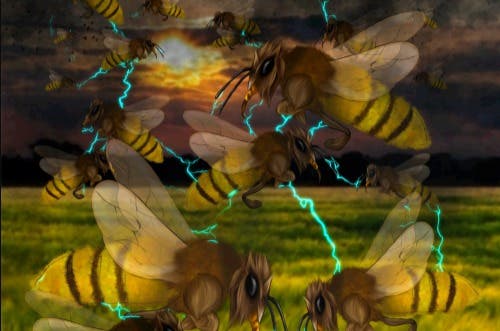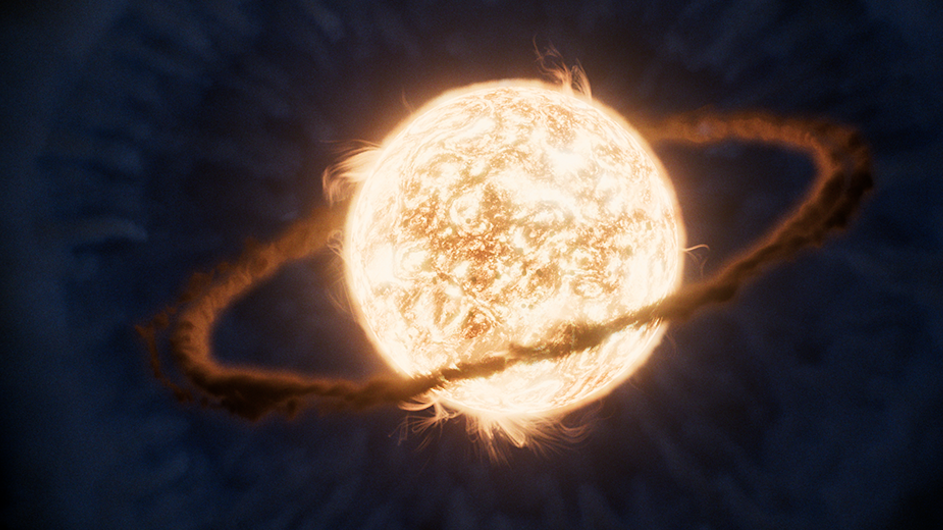Insects affect electric fields in the atmosphere, researchers find
The electric charge of insects can cause changes in the electricity of the atmosphere which are comparable with weather processes.

[Oct 26, 2022: Ellard Hunting, University of Bristol]
Aerial insects carry an electric charge. Swarming honeybees have a density-dependent effect on atmospheric electricity. (CREDIT: University of Bristol)
The electric charge of insects can cause changes in the electricity of the atmosphere which are comparable with weather processes, researchers at the University of Bristol and University of Reading have found.
By measuring atmospheric electricity near a swarm of bees in flight, this study, published today in iScience, is the first to recognise biology as a source of space charge in the atmosphere.
Previously, the team have studied how different organisms use the static electric fields that are virtually everywhere in the environment. They have shown that bees and spiders use electric fields surrounding flowers for foraging and migration.
“We essentially always looked at how physics influenced biology, but at some point, we realized that biology might also be influencing physics,’ explained Dr Ellard Hunting, lead author of the paper and ecologist at Bristol’s School of Biological Sciences.
Related News
The honeybee swarm directly contributed to atmospheric electricity, in proportion to swarm density. The team evaluated its relevance by calculating the electrical contribution of various swarming insect species and comparing this with common abiotic – physical, not biological, sources of charge.
This revealed that the charge contribution of some insect swarms can be comparable with that of meteorologically-induced variations. The observed transport of charge by insects therefore demonstrates an unexplored role of biogenic space charge for physical and ecological processes in the atmosphere.
Atmospheric physicist Prof. Giles Harrison from the University of Reading said: “Interdisciplinarity is always valuable - electric charge can seem like it lives solely in physics, but it is important to know how aware the whole natural world is of electricity in the atmosphere.
Effect of honeybee swarms on the atmospheric potential gradient, PG. (A) Honeybees passing the electric field monitor at the experimental site. (B) Finite element model illustrating the potential effect of a honeybee swarm on atmospheric PG (in V/m). Color scale truncated above 300 V/m. (CREDIT: University of Bristol)
“Thinking more broadly, linking biology and physics might help with many puzzling problems, such as why large dust particles are found so far from the Sahara, which cannot be explained with existing ideas.”
The observed phenomenon is likely also relevant for other organisms in the atmosphere that carry an electric charge, including microbes and birds.
Effect of a locust swarm on the atmospheric potential gradient and the significance of insect swarm compared with meteorological conditions. (A) Example of a locust swarm (Courtesy: Bilal Tarabey-AFP). (B) Finite element model showing the effect of a locust swarm on atmospheric PG (in V/m). Color scale truncated above 300 V/m. (CREDIT: University of Bristol)
Ellard added: “It would be interesting to study how these organisms interact with other atmospheric processes such as the fluxes of ions and aerosols.”
Paper:
‘Observed electric charge of insect swarms and their contribution to atmospheric electricity’ by Ellard Hunting, Liam O’Reilly, Giles Harrison et al in iScience.
Note: Materials provided above by the University of Bristol. Content may be edited for style and length.
Like these kind of feel good stories? Get the Brighter Side of News' newsletter.
Joseph Shavit
Head Science News Writer | Communicating Innovation & Discovery
Based in Los Angeles, Joseph Shavit is an accomplished science journalist, head science news writer and co-founder at The Brighter Side of News, where he translates cutting-edge discoveries into compelling stories for a broad audience. With a strong background spanning science, business, product management, media leadership, and entrepreneurship, Joseph brings a unique perspective to science communication. His expertise allows him to uncover the intersection of technological advancements and market potential, shedding light on how groundbreaking research evolves into transformative products and industries.



